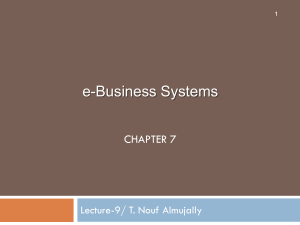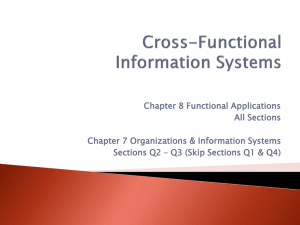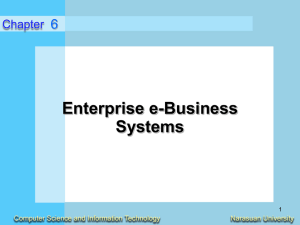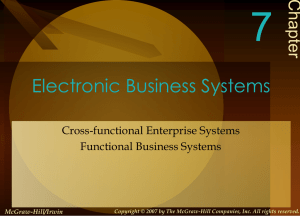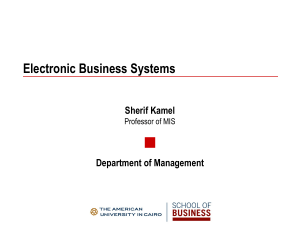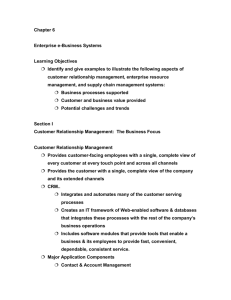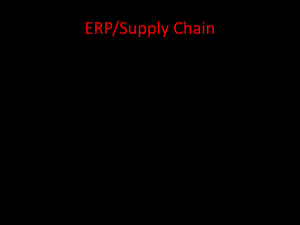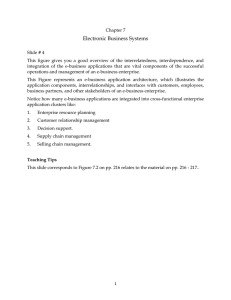CH 7
advertisement
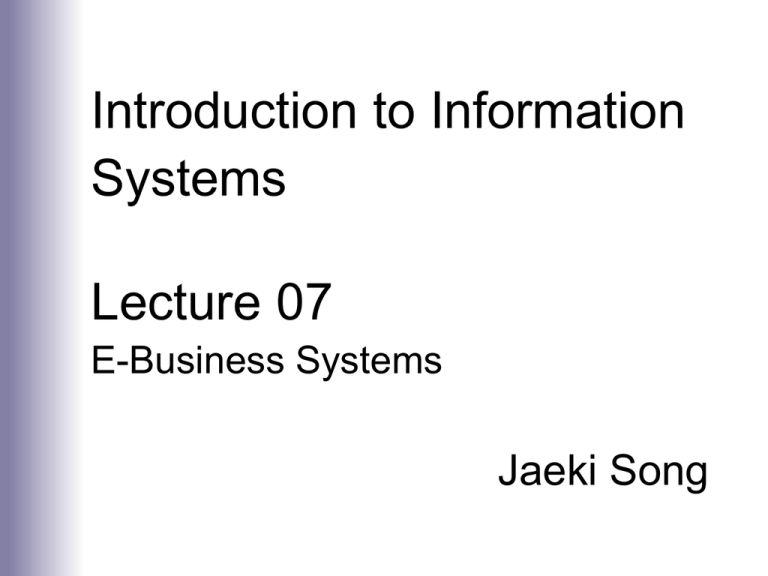
Introduction to Information Systems Lecture 07 E-Business Systems Jaeki Song Learning Objectives 1. Identify the following cross-functional enterprise systems, and give examples of how they can provide significant business value to a company. 2. Give examples of how Internet and other information technologies support business processes within the business functions. 3. Understand the need for enterprise application integration to improve support of business interactions across multiple e-business applications. 7-2 Cross-functional Systems • Cross the boundaries of traditional business functions • In order to reengineer and improve vital business processes all across the enterprise 7-3 Customer Relationship Management (CRM) • CRM uses technology to • Create a cross-functional enterprise system • Create a framework of web-enabled software and databases that integrate these processes with the rest of the company’s processes in marketing, sales, and customer service 7-4 CRM applications • Contract and Account Management • Helps sales, marketing and service professionals • Sales • Provides sales reps with software tools and data they need to support and manage sales activities • Up selling • The process of finding ways to sell a new or existing customer a better product than they are currently using • Cross selling • An approach in which a customer of one product or service may be interested in purchasing a related product or service. • Marketing and Fulfillment • Help marketing professionals accomplish direct marketing campaigns by tasks 7-5 CRM applications • Customer Service and Support • Provides sales reps with software tools and database access to customer database shared by sales and marketing professions • Retention and Loyalty Programs • Try to help a company identify, reward, and market to their most loyal and profitable customers • Data mining tools and analytical software • Customer data warehouse 7-6 The Three Phases of CRM • CRM tools help • Acquire • New customers • Enhance • Keep customers happy • Retain • Proactively identify and reward its most loyal and profitable customers 7-7 CRM • Benefits • Identify and target best customers • Real-time customization and personalization of products and services • Track when a customer contacts a company • Failure • Lack of understanding and preparation • Rely on application to solve a problem without first changing the business processes • Business stakeholders not participating and not prepared 7-8 Enterprise Resource Planning (ERP) • Cross-functional enterprise system • with an integrated suite of software modules • that support the basic internal business processes of a company • Business benefits • • • • Quality and efficiency Decreased costs Decision support Enterprise agility 7-9 Costs of implementing a new ERP 7-10 Causes of ERP failure • Underestimating the complexity of planning, development and training • Failure to involve affected employees in planning and development • Trying to do too much too fast • Insufficient training in new work tasks • Failure to do enough data conversion and testing • Over reliance on ERP vendor or consulting companies 7-11 Supply Chain Management (SCM) • A cross-functional interenterprise system • To help support and manage the links between a company’s key business processes • And those of its suppliers, customers and business partners 7-12 SCM goal • Developing the most efficient and effective sourcing and procurement processes with suppliers for the products and services needed by a business. • Fast, efficient, low-cost network of business relationships or supply chain to get a company’s products from concept to market • A supply chain: • Interrelationships with suppliers, customers, distributors, and other businesses that are needed to design, build and sell a product 7-13 Causes of problems in SCM • Lack of proper demand-planning knowledge, tools and guidelines • Inaccurate or overoptimistic demand forecasts • Inaccurate production, inventory, and other data • Lack of adequate collaboration within the company and between partners • SCM software considered immature, incomplete and hard to implement 7-14 Enterprise Application Integration (EAI) • EAI connects cross-functional systems • Serves as middleware to • Provide data conversion • Communication between systems • Access to system interfaces 7-15 Enterprise Collaboration Systems (ECS) • ECS • Cross-functional IS that enhance communication, coordination and collaboration among the members of business teams and workgroups • ECS Goals • Communicate: share information with each other • Coordinate: coordinate individual work efforts and use of resources with each other • Collaborate: work together cooperatively on joint projects and assignments 7-16 Functional Business Systems • A variety of information systems (transaction processing, management information systems, decision support, etc.) • That support the business functions of • Accounting, finance, marketing, operations management and human resource management 7-17 Marketing Information Systems • Interactive marketing • A customer-focused marketing process • to profitably attract and keep customers • Targeted Marketing • Sales Force Management • Speeds up capture and analysis of sales data from the field to marketing managers • Gain strategic advantage 7-18 Manufacturing Information Systems • Support the production/operations function • Includes all activities concerned with planning and control of producing goods or services 7-19 Human Resource Management (HRM) • Information systems designed to support • Planning to meet the personnel needs of the business • Development of employees to their full potential • Control of all personnel policies and programs 7-20 Employee Self-Service (ESS) • Intranet applications that allow employees to • • • • • View benefits Enter travel and expense reports Verify employment and salary information Update their personal information Enter data that has a time constraint to it 7-21 Accounting Information Systems • Record and report the flow of funds through an organization • Produce financial statements • Forecasts of future conditions • Six essentials • Order processing, Inventory control, Account receivable, Account payable, Payroll, General ledger 7-22 Financial Management Systems • Support business managers and professionals in decisions concerning • The financing of a business • The allocation and control of financial resources within a business 7-23

